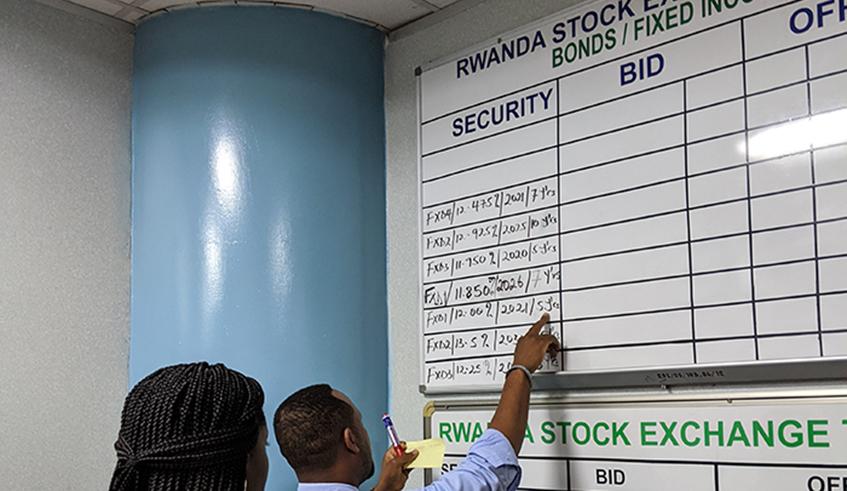Africa-Press – Rwanda. The bond market is by far the largest securities market in the world, providing many potential benefits to investment portfolios, including attractive returns, according to Pierre-Célestin Rwabukumba, Chief Executive Officer of Rwanda Stock Exchange (RSE).
Majority of investors locally and across the world are familiar with aspects of the market, but as the number of new products grows, a big percentage of the population is challenged to keep pace.
However, to further understand the complexities of this huge and diverse market, Doing Business breaks down the common basics; what is a bond and how can bonds help meet your investment goals?
In essence, a bond is a certificate issued by a borrower (a Company or Government) as evidence that the borrower owes the bond holder (creditor) a specified sum of money.
For the most part, governments, corporations and municipalities issue bonds when they need capital.
An investor who buys a government bond is lending the government money.
If an investor buys a corporate bond, the investor is lending the corporation money.
Like a loan, a bond pays interest periodically and repays the principal at a stated time, commonly known as maturity.
How does it work?
If a certain corporation wants to build a new manufacturing plan for Rwf1 billion, and they decide to issue a bond offering to help pay for the plant.
The corporation might decide to sell 1,000 000 bonds to investors for Rwf1,000 each.
In this case, the “face value” of each bond is Rwf1,000. Face value is the amount paid to a bond holder at the maturity date.
The corporation – now referred to as the borrower − determines an annual interest rate, known as the coupon, and a time frame within which it will repay the principal, or the Rwf1 billion.
To set the coupon, the borrower takes into account the prevailing interest rate environment to ensure that the coupon is competitive with those on comparable bonds and attractive to investors.
For instance, the borrower may decide to sell two year bonds with an annual coupon of 5 per cent.
At the end of every two years, the bond reaches maturity and the corporation repays the face value to each bondholder.
A look at Rwanda’s bond market
According to Rwabukumba, the bond market in Rwanda has started to meet the expectations especially in terms of raising long term funding for the economy and promoting the culture of saving among the Rwandans, as well as fostering the culture of corporate governance.
“Around Rwf 800 billion was raised and at least Rwf 60 billion traded in the secondary market so far” he said.
The government started the bond issuance programme in 2008, but hit a snag the same year due to the global financial crisis. It resumed issuance in 2010 and 2011, with small issuances of Rwf10 billion.
Rwabukumba attributed the vibrant market on government treasury bonds that have dominated the market.
“On the bonds market alone of course predominantly by government issuing T- Bonds and a few corporate bonds and now commercial papers being issued by other private players.”
He added, “Investors are local domestic institutions, retailers and also internationals”
Rwabukumba pointed out that the past two years has led to a surge in retailer investors.
“In the beginning , we had seen resistance from retail investors but in recent years especially the past 2 years we have seen a surge. Also joining banks and insurance companies and other institutional investors where in some of the government issues to the market retail investors have surpassed 28 per cent uptake on one issue and their participation is north of 10 per cent on average which is fairly unusual comparatively to our counterparts in the regional or the continent where you often find retail investors averaging lower than 5 per cent in government bond issuances,” he said.
This, he said, is a sign of the public trusting the government paper more, citing that it also translates into the government ability to pay back and the returns are good and stable.
“Right now we have 25 bonds outstanding on the market today,” he said.
Rwabukumba decried that one of the challenges faced earlier is the fact that investors in government debt tend to hatch out their stock until maturity period, resulting in a nascent secondary market.
“Well the issue of keeping your securities till maturity is very common in illiquid markets but in ours particularly, it was mainly caused by lack or limited financial literacy but most importantly it was also caused by lack of products on the market,” he said.
“People did not have enough choice and the issuance was not consistent or rather sporadic therefore not predictable by investors for their own planning purposes,” he added.
Consequently, he said that one has different choices and the issuance is more frequent and consistent thus giving the investors alternative choices and different maturities which has given them more confidence and choices between different securities and as a result the trading volumes have increased remarkably.
He further explained that some of the incentives put in place to curb this practice include, withholding tax on interest income which is 5 per cent for securities of 3 year maturity and above and also no capital gains or VAT on secondary market trading.






